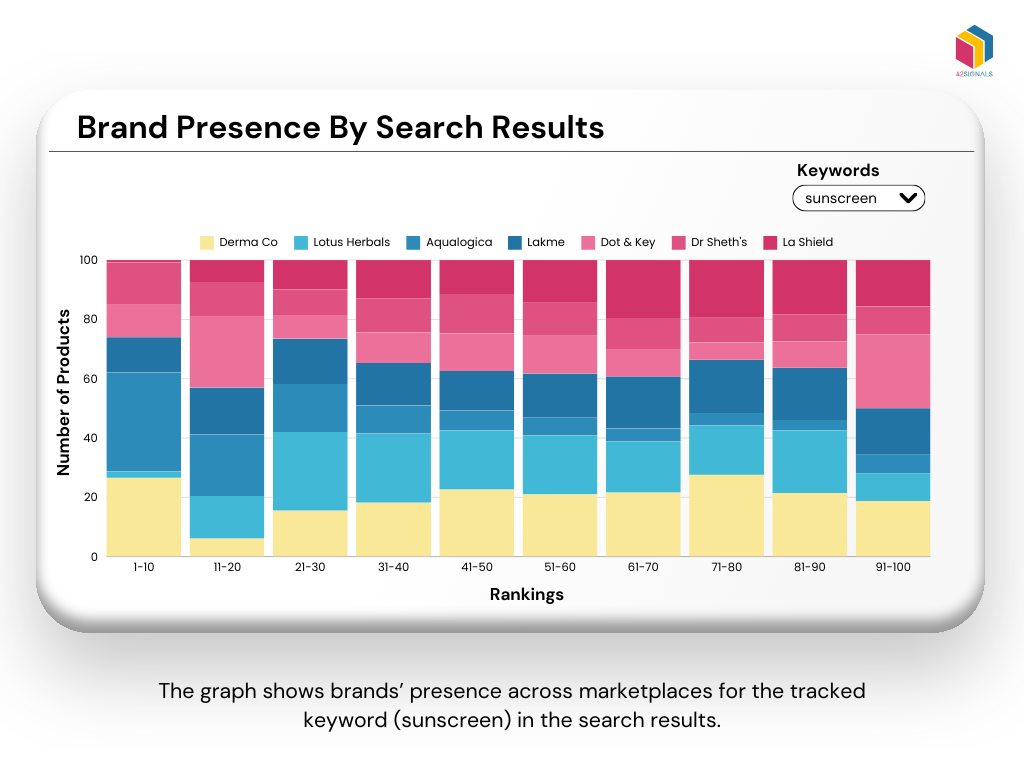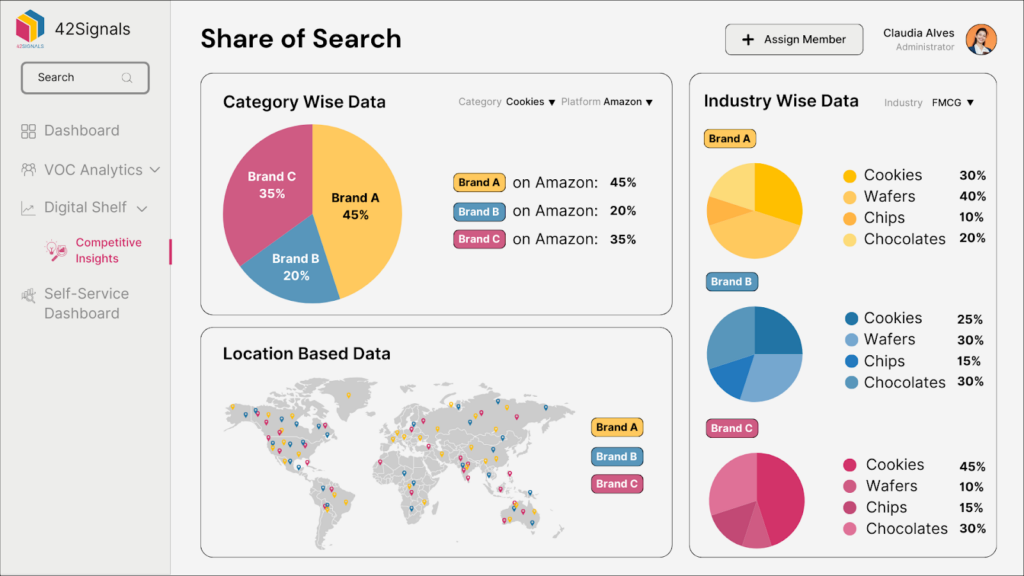The competition in online marketplaces has reached new heights, making it essential for e-commerce businesses to find creative ways to appear front and center when potential customers search for products. So, what’s the need to optimize for search in ecommerce?
Standing out in search results across various platforms, including Google, Amazon, and Walmart, requires a range of techniques that help drive visibility.
Optimizing for search today is about more than just keywords—it’s a blend of strategy, analytics, and a deep understanding of how different e-commerce search engines rank products.
Building a presence, or what’s known as “share of search,” on platforms like Amazon and Walmart is increasingly important for brand success. This share of search reflects how often your brand shows up in key search results compared to competitors.
And since customers are searching for products across platforms, each with unique ranking formulas, businesses need to be strategic in how they present their products.
Here’s a close look at the methods online retailers can use to boost their visibility on these high-traffic sites, with some foundational insights into how Google search can also contribute to broader e-commerce success.
How do you build a strong search share on Google?
Google is often the starting point for online shoppers. Even when a customer intends to make a purchase on Amazon or Walmart, they often begin by browsing through Google to gather information and compare products.

Image Source: Proceed Innovative
Because of this behavior, being highly visible on Google is an essential part of any e-commerce strategy. Google search optimization helps attract users who may later complete their purchase on other platforms, contributing to overall brand recognition and visibility.
Key Ways to Optimize Google Search in E-Commerce
- Effective Keyword Strategy: Target high-interest keywords related to your products and industry. Tools like Google Keyword Planner and Ahrefs help you pinpoint phrases people are actively searching for, giving you a list of relevant terms to weave into your product pages.
- Enhanced Product Pages: Crafting compelling product pages that speak directly to customers’ needs is crucial. This means incorporating keywords, but also delivering descriptive titles, well-crafted explanations of product benefits, and unique features. These elements work together to improve how your products rank.
- Structured Data: Structured data, or “rich snippets,” allow Google to highlight your products with additional information, such as price, availability, and customer ratings. This extra information in search results can significantly improve click-through rates, giving you an edge over competitors with less detailed entries.
- Content That Engages: A strong content marketing strategy—such as blog articles, buying guides, and how-to videos—can draw in customers and keep your brand top-of-mind. By targeting searches related to your products, such as tips and comparisons, content brings new customers to your site, introducing them to your brand in a helpful way.
Mastering these tactics on Google helps online retailers build a presence that can feed directly into brand loyalty and ultimately help drive purchases on Amazon, Walmart, and beyond.
How to Maximize Product Visibility on Amazon?
Amazon’s search in ecommerce process revolves around its A9 algorithm, which places a strong focus on relevance, product quality, and customer satisfaction metrics.

Achieving success on Amazon requires a sharp focus on keyword choice, attention to how listings are crafted, and an understanding of Amazon’s unique ranking signals.
a. Thoughtful Keyword Use
Amazon’s search algorithm leans heavily on keywords. Retailers should carefully research and choose phrases that best describe their products and match the words customers use when searching. Tools like 42Signals can help identify high-impact phrases for Amazon and help with the search in ecommerce.
To optimize your presence, it’s helpful to place these keywords in:
- Titles and Descriptions: Position your main keywords in the product title and description. The title is often the first thing shoppers notice, so make it clear and relevant.
- Backend Keywords: Amazon allows sellers to add extra keywords on the backend that don’t show up on the public product page. Use these fields to add relevant terms that customers might search for.
- Bullets and Product Descriptions: This section allows you to give shoppers a quick overview of key features, benefits, and uses. Use this opportunity to reinforce secondary keywords while addressing customers’ questions.
b. Well-Structured Product Listings
Amazon’s algorithm also rewards listings that encourage clicks and conversions, so creating an inviting, clear, and informative product page is essential.
- Visual Appeal: High-quality images are central to any Amazon listing. Aim for photos that capture all angles and details, giving potential buyers a full understanding of what they’re purchasing.
- Concise, Informative Descriptions: Keep your product descriptions clear and benefit-focused. Highlight what makes your product unique and valuable to buyers, addressing any specific needs they might have.
- Positive Customer Ratings: Reviews and ratings are influential in determining Amazon’s rankings. Engaging with customers to encourage positive reviews can significantly affect how your products rank.
c. Paid Ads on Amazon
Using Amazon’s Sponsored Ads is an effective way to get your products noticed quickly, especially in crowded categories. Paid ads can help increase visibility for newer items, drive traffic, and ultimately build momentum for organic rankings. Regularly monitoring performance and refining your ads helps you stay competitive without overspending.
Top Tips for Enhancing Search Visibility on Walmart Marketplace
Walmart’s online store has become an increasingly important player, and as a relatively newer platform, it provides fresh opportunities to attract customers.

Walmart’s ranking system favors a blend of product relevance, competitive pricing, and effective fulfillment options.
a. Keyword Integration
Although Walmart’s keyword system is less complex than Amazon’s, using the right phrases is still vital. Optimize titles and descriptions with the most relevant terms to improve how products appear in Walmart searches. Walmart’s search in ecommerce bar can provide insights into frequently used phrases, helping guide your choices.
b. Price Competitiveness
Pricing is central to Walmart’s algorithm. Walmart favors items priced to compete directly with similar listings. Regularly reviewing your product’s price in comparison to others in the same category can help you keep a favorable position.
c. Shipping and Fulfillment
Walmart tends to rank products higher when they offer fast and reliable delivery options. Using Walmart’s TwoDay delivery service or Walmart Fulfillment Services (WFS) can improve your standing on the site, giving shoppers peace of mind about delivery speed and reliability.
d. Walmart Sponsored Products
Similar to Amazon’s ads, Walmart Sponsored Products increase the chance of visibility in search results. These ads allow you to highlight products for particular keywords, helping you secure a top position and compete with established brands in the marketplace.
Learn more about Walmart’s eCommerce tactics.
How Digital Shelf Analytics Can Boost Your Competitive Advantage?
Digital shelf analytics refers to tools that monitor how your brand appears across online marketplaces. By tracking keywords, rankings, and competitor placements, these tools help sellers understand and improve their share of searches.
Having a strong “digital shelf” presence means your products consistently show up where customers are searching, increasing the chance of being noticed and selected.

Image Source: Back Linko
With digital shelf analytics, e-commerce businesses can:
- Track Search Positioning: See how your products rank for specific terms across various platforms. This knowledge allows you to adjust your keywords and product pages in response to competition.
- Spot Opportunities: Identify gaps where competitors are leading and refine your approach to reclaim visibility.
- Optimize for Consistency Across Platforms: A data-backed approach makes it easier to manage your listings effectively, creating a unified presence that resonates with online shoppers.
Top digital shelf analytics tools, like 42Signals, allow sellers to measure performance, strategize for improvement, and refine product pages based on real-time insights.
How E-Commerce Analytics Fuel Ongoing Business Growth?
E-commerce analytics is a broader approach to performance tracking, covering not just search visibility but also competitor data, customer behavior, purchasing patterns, and the factors that drive sales. With this approach, online retailers can dig into valuable details that provide a complete picture of their performance.
E-commerce analytics tools provide:
- Customer Insights: Learn about customer browsing and purchasing behaviors to adapt your marketing approach.
- Return on Ad Spend (ROAS): Track the effectiveness of ad campaigns to see if you’re reaching the right audience and making the best use of your ad budget.
- Product Performance Evaluation: Identify high-performing items, as well as products that need adjustments to attract more buyers.
Top platforms for e-commerce analytics, such as Google Analytics and Amazon’s Brand Analytics, or even 42Signals give businesses a data-driven approach to optimizing product listings, tracking audience behavior, and boosting conversions.
Conclusion:
Optimizing search in ecommerce across multiple e-commerce is essential for building visibility and staying competitive.
With an effective approach to share of search on Amazon and Walmart, combined with the right presence on Google, businesses can capture the attention of online shoppers wherever they may be looking.
42Signals helps businesses of all sizes target their customers with the right data and optimizations. Schedule a demo to see it in action.




